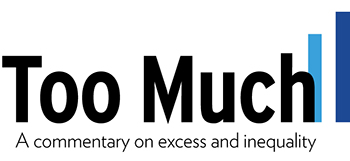Yes, the poor have struggled mightily while our rich have become phenomenally flush. But middle-income Americans haven’t been able to jump off the treadmill either.
By Sam Pizzigati
We’ve all heard plenty of chatter over recent years about the widening gap “between rich and poor.” But what about the gap between rich and middle? This divide seldom ever gets much media play, an inattention that makes no sense. The gap between America’s high-income and middle-income households, after all, has been growing almost as fast as the gap between rich and poor.
The latest evidence: a new income inequality study from two of Washington’s most respected research groups, the Center for Budget and Policy Priorities and the Economic Policy Institute.
These two groups have been tracking U.S. income disparities, on a state-by-state basis, for years now, and they publish their findings in a report series they’ve titled Pulling Apart. The latest Pulling Apart, released just last week, takes our inequality story through our new century’s first decade.
The core story hasn’t changed much. The gap between America’s poorest 20 percent and America’s most affluent 20 percent continues to stretch out.
In the three-year span from 2008 through 2010, in 15 different states, our most affluent 20 percent averaged over eight times the income of our poorest 20 percent. Back in the late 1970s, the new Pulling Apart points out, not one single state had a top-to-bottom ratio that ran over eight times.
Overall, after adjusting for inflation, the nation’s richest fifth of households have seen their incomes rise an average $2,550 each year since the late 1970s. Average incomes in the nation’s bottom fifth have increased a mere $1,330 for the entire last three decades.
In all 50 states, the gap between top 20 and middle 20 percent has widened ‘significantly.’
And incomes for the households in America’s middle fifth? In all 50 states, the gap between top 20 and middle 20 percent has widened “significantly.” The gap between middle 20 percent and top 5 percent has widened even more.
In New York, for instance, the average, inflation-adjusted incomes of the state’s middle fifth increased by just $14,118 between 1977-1979 and 2005-2007. Over that same time span, top 5 percent incomes soared by $193,877.
The new Pulling Apart zeroes in on 11 of America’s largest states. Back in the late 1970s, the top 5 percent of households in these states averaged 2.8 times more income than households in the middle 20 percent. The ratio three decades later: 4.7 times. In one state, Illinois, the gap essentially doubled.
All these figures, the new Pulling Apart emphasizes, “understate” the real gap between our affluent and everyone else. The data for Pulling Apart come from the surveys on household income that the Census Bureau conducts every year. These Census surveys do not take into account income from capital gains, the profits that come from buying and selling stocks and bonds and other assets.
Capital gains income, Pulling Apart notes, goes “overwhelmingly” to America’s most affluent. In 2012, 87 percent of all capital gains “will go to families in the top 5 percent of the U.S. income distribution.” The gaps the new Pulling Apart details would be substantially wider if we took this income into account.
But do these gaps, in the end, matter all that much? The researchers behind the new Pulling Apart have a clear answer. Rising inequality, they contend, “adversely affects our economy and political system.” The most basic problem with growing income gaps? They eat away at our social cohesion.
Rising inequality eats away at our social cohesion.
In a democracy, the civics textbooks tell us, people come together to discuss, debate, and decide solutions to the common problems they face. But this democratic deliberation only works effectively when most people have the same problems in common. In deeply unequal societies, they don’t. The rich in these societies live apart, in their own private universes.
These wealthy, Pulling Apart observes, “become increasingly isolated from poor and middle-income communities” as income gaps widen. One example: They send their children to private schools and “can lose sight of the need to support public schools.”
“As a result,” Pulling Apart explains, “support for the taxes necessary to finance government programs declines, even as the nation’s overall ability to pay taxes rises.” This “failure to invest adequately in programs that educate children,” in turn, “can dampen” our future economic growth.
 The encouraging news in the new Pulling Apart? We may still have gridlock in Washington, but states, individually, can take steps to narrow the gaps that divide our rich from our poor and our middle. States can enact state minimum wages higher than the federal minimum wage rate. They can de-emphasize sales taxes and focus instead on taxing the income of ultra wealthy households.
The encouraging news in the new Pulling Apart? We may still have gridlock in Washington, but states, individually, can take steps to narrow the gaps that divide our rich from our poor and our middle. States can enact state minimum wages higher than the federal minimum wage rate. They can de-emphasize sales taxes and focus instead on taxing the income of ultra wealthy households.
The payoff from moves like these?
“States that narrow — rather than widen — income gaps,” promises Pulling Apart co-author Elizabeth McNichol, “will reap economic benefits in the long run.”
Veteran labor journalist Sam Pizzigati, an Institute for Policy Studies associate fellow, writes widely about inequality. His latest book, The Rich Don’t Always Win: The Forgotten Triumph over Plutocracy that Created the American Middle Class, will be published next week.




The rich get richer while ” the poor help the rich get richer”.